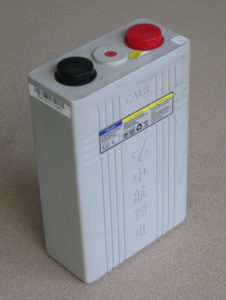 Compared to lead-acid batteries Lithium Iron Phosphate (abbreviated LiFePO4 or just LFP) batteries are simple to charge and quite forgiving about voltage set points. You can use most “12-V” lead-acid solar charge controllers to charge a 12.8 V LFP battery. On those with adjustable settings, here are our recommendations for voltage set-points and why.
Compared to lead-acid batteries Lithium Iron Phosphate (abbreviated LiFePO4 or just LFP) batteries are simple to charge and quite forgiving about voltage set points. You can use most “12-V” lead-acid solar charge controllers to charge a 12.8 V LFP battery. On those with adjustable settings, here are our recommendations for voltage set-points and why.
Assumptions: Solar powered system in tropical or temperate zones, i.e. temperatures are always well above freezing, and charging stops every night when the sun goes down.
Significant differences lead-acid vs. LFP:
Lead-acid batteries need to be kept at their “absorb” voltage (14.1 V to 14.8 V depending on type) for several hours before they are fully charged. LFP batteries do not need an “absorb” time; they are ~98% charged when the voltage hits 14.0 V, and current in will drop to a trickle within a few minutes. It does not hurt them to be kept floated at between 13.7 V and 14.6 V for several hours a day, but it is not at all necessary and current will be minuscule. It is actually better for the total cycle life of LFP batteries if they DO NOT get a 100% full charge every day.
Lead-acid batteries need the charging voltages adjusted down slightly when the temperature gets above the design temperature of 25 °C. Some charge controllers have a temperature probe option and will compensate. LFP batteries do not need temperature compensation of charging voltages.
After reaching a full charge, lead-acid batteries with no load will naturally drop down to about 12.8 V or a little lower, whereas LFP batteries with no load will sit around 13.5 V or 13.6 V. The no-load voltage of LFP batteries won’t reach 12.8 until they are ~80% discharged.
Most solar charge controllers made for lead-acid batteries do three phase charging.
Phase 1 is “bulk” charging and restarts every morning. During this phase all of the power from the panels is dumped into the batteries. The current is limited only by what the panels can put out. This works the same for LFP or lead-acid
Phase 2 starts when the battery voltage rises to the “absorb voltage” (sometimes called “bulk voltage”). The charge controller will limit the current from the panels to keep the voltage from rising any higher. This “absorb voltage” is usually settable. The “flooded” setting is the highest voltage, usually 14.4 V or higher, which might possibly be used for LFP batteries if you have balancers installed, but beware, sometimes the “flooded” setting will do a weekly or monthly “equalize” at an even higher voltage, and this would be very bad for your LFP battery. If you lack a manual for your charge controller and don’t know for sure, do not choose the “flooded” setting on your charge controller. Instead, choose the “Gel” “AGM” or “sealed” setting (labeling varies). Any of those settings will have a lower absorb voltage somewhere between 14.1 V and 14.3 V and NO equalize cycle. They will work great with LFP batteries. If your battery doesn’t have cell balancers, it will probably last a little longer if you choose a lower voltage setting closer to 14.0 V, but it’s not at all critical.
Phase 2 (absorb cycle) ends when either a time limit is hit, or the charging current falls to some low number for a few minutes, depending on your charge controller’s manufacturer. Either method will work fine with LFP batteries. If you have the option of setting the absorb time, set it as low as possible.
Phase 3 Is usually a float cycle that will continue until the sun sets. A float voltage of anywhere between 13.6 V and 14.4 V will work fine with LFP batteries. If you have a choice, choose 13.7 V. This will keep the loads from drawing any current out of your battery as long as the sun is shining. Anything below 13.6 V will waste sunshine since it won’t pass energy to the loads until the battery is significantly discharged.
Equalize is BAD Some charge controllers can do a monthly automatic or manually initialized “equalize” cycle. This is only done for “flooded” lead-acid batteries, and raises the battery voltage above 15 V for a timed period, usually over an hour. This brings all the cells to a full charge balancing the cells, but also boils off some of the electrolyte. You have to add distilled water to the battery after equalizing. You must make sure equalize is disabled when using LFP batteries, it will damage them!
LVD Some charge controllers have a Low Voltage Disconnect (LVD) sometimes called low voltage cutoff (or your inverter will have a LVD voltage). It is critical for the health of your batteries to avoid excessive discharge, especially for LFP batteries. If you get below 2.0 V on any of the four cells, a LFP battery will be instantly ruined and no longer take a charge. Most manufacturers recommend a low voltage cutoff of no less than 10.5 V, but there is no advantage to you to set it this low. At 11.5 V the battery is 99% dead and you can only get another minute or two out of it before it drops to 10.5 V, so don’t set the LVD below 11.5 V if you have any control at all. When your battery gets old, and some cells are weaker than the others, it will last a lot longer if you haven’t been pushing the lower limit. We recommend you set the LVD to 12.0 V to 12.7 V. Higher is better for the battery. 12.0 V is around 95% depth of discharge (DOD.) At 12.7 V you will be cutting out at about 85% DOD and you will get many years of use out of your battery. Depending on the amperage of the loads and your wire size, you may need to adjust the LVD voltage down by several tenths to account for voltage drops in the wiring.
For all of the above reasons, if you have a charge controller with settable voltages like the Xantrex C12, we recommend the following settings:
For batteries with balancers:
- HVD = 14.4 V (absorb voltage)
- HVR = 13.7 V (float voltage)
- LVR = 13.3 V (reconnect loads after a disconnect)
- LVD = 12.7 V (disconnect loads when at 85% DOD)
For batteries without balancers (or with) a lower absorb voltage should prolong the life:
- HVD = 14.0 V
- HVR = 13.7 V
- LVR = 13.3 V
- LVD = 12.7 V
Safety considerations at battery end-of-life
When one of the cells in a LFP battery fails either from over-discharge, old age or a defect, the battery voltage will be low and remain low even when charging. A good charge controller designed for LFP will limit current to a trickle if the battery voltage is below 10.5 V, but controllers designed for lead-acid might not. The dead cell will get warm and build up pressure inside, causing the battery to visibly swell. If charging continues, it could pop the pressure relief valve and suddenly vent nasty fumes into the room. Users should be trained to watch out for low battery voltage (< 10.5 V) or battery swelling and not attempt to charge the battery if either occurs.

 GTIS Power and Communications Systems
GTIS Power and Communications Systems